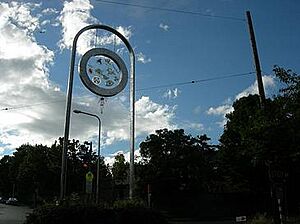Lawney Reyes facts for kids
Quick facts for kids
Lawney Reyes
|
|
|---|---|

Reyes in 2016
|
|
| Born | 1931 Bend, Oregon, U.S.
|
| Died | (aged 91) |


Lawney L. Reyes (1931 – August 10, 2022) was an American artist, curator, and writer. He was a member of the Sin-Aikst people and lived in Seattle, Washington. As a curator, he helped organize art collections. As a memoirist, he wrote books about his life and family.
Contents
About Lawney Reyes
Lawney Reyes was born in 1931 in Bend, Oregon. His mother, Mary Christian, was from the Sin-Aikst people. Today, they are part of the Confederated Tribes of the Colville Reservation. His father, Julian Reyes, was from the Philippines. Lawney had two siblings, Luana Reyes and Bernie Whitebear, who were also well-known.
Early Life and Education
Lawney spent his early childhood on the Colville Indian Reservation in Washington. From 1935 to 1937, his parents ran a Chinese restaurant near the Grand Coulee Dam construction site. His parents later separated.
From 1940 to 1942, Lawney attended the Chemawa Indian School. This was a boarding school for Native American children. He later wrote that talking with other students there helped him understand what it meant to be "Indian." He finished high school in Okanogan, Washington, in 1949.
After high school, Lawney joined the U.S. Army. This gave him the chance to travel around Europe. These travels made him interested in architecture, design, and art. When he returned, he studied painting, sculpture, and interior design at the University of Washington. He graduated in 1959.
Career and Writings
Lawney Reyes worked for Seafirst Bank as a designer. He eventually became responsible for collecting and organizing the bank's art collection. In his free time, he created sculptures, mostly from wood, and worked as a freelance interior designer.
He retired early from Seafirst Bank in 1984. After retiring, he traveled across North America to visit different Native American tribes. He also wrote two important books:
- White Grizzly Bear's Legacy: Learning to be Indian (2002)
- Bernie Whitebear: An Urban Indian's Quest for Justice (2006)
His first book, White Grizzly Bear's Legacy, shares his own memories and research. It also includes notes from his mother. The book describes traditional tribal fishing at Kettle Falls on the Columbia River. It also talks about how the Sin-Aikst people's lives changed after the Grand Coulee Dam was built. The dam flooded their traditional lands. He also wrote about how schools like Chemawa Indian School shaped Native American identity.
His second book, Bernie Whitebear: An Urban Indian's Quest for Justice, is about his brother, Bernie Whitebear. Bernie was a leader who helped start the Minority Executive Directors' Coalition in Seattle.
Lawney's third book, B Street: A Gathering of Saints and Sinners (2008), explores the Grand Coulee area during the dam's construction.
Sculpture and Design Works
Lawney Reyes' art can be seen in many places in Seattle. He helped design the Daybreak Star Cultural Center. His large sculpture called Blue Jay is 30 feet wide and 12 feet high. It was displayed at the Bank of California building for over 30 years. Later, it was moved to the Daybreak Star Center.
His sculpture Dreamcatcher is located in Seattle at 32nd Avenue and Yesler Way. This artwork honors the memory of his brother Bernie and his sister Luana.
Awards and Honors
Lawney Reyes received several awards for his contributions to art:
- He was a Commissioner of the Seattle Arts Commission.
- He was a member of the Washington Governor's Task Force for the state's arts budget.
- He received the Washington State Arts Commission Governor's Arts Award in 1971.
Death
Lawney Reyes passed away on August 10, 2022, at the age of 91.
Images for kids
-
Detail from Reyes' 1972 sculpture Blue Jay. The eye of the blue jay, depicted here — a roughly 0.25 meter detail in this 30 meter-wide sculpture — is a depiction of a bear holding a white man, in tribute to Reyes' activist brother, Bernie Whitebear. The sculpture is modeled on Coast Salish tradition, although Reyes and Whitebear were (inland) Sin-Aikst.
-
Reyes' Dreamcatcher sculpture, installed at 32nd Avenue and Yesler Way in Seattle, is a public memorial to his brother Bernie Whitebear and sister Luana Reyes. The sculpture also relates to cultural diffusion among Native American tribes/nations. As noted on the plaque, dreamcatchers are originally an Ojibwa cultural artifact, but have now been adopted by Native Americans throughout the United States and Canada.



